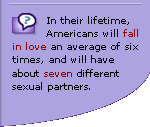 |  |  |
|
 | When you think about drinking and driving, invariably Mothers Against Drunk Driving will come up. RADD might too, but who cares about pansy-ass rockers who can't drink? Anyway, MADD does a lot of good work to prevent drunk driving, if a bit stridently, so it makes sense to hear a little from them.
Below is a list of drinking facts presented by MADD. Given MADD's obvious agendas, we encourage you to take the following with a grain of salt (and if reading the word "salt" makes you think "tequila shots", you may very well have a problem.) Regardless, drunk driving is a serious problem for everybody, so dont' do it! These are all good things to think about, and it's very important to realize how much you're drinking, how much control you have, and how to be safe when you're out having fun.
So what do the Mothers have to say about drinking and driving? Let's take a look:
We all think that we are invincible at some point in time in our lives. Unfortunately, however, we are not, and we are especiallyvulnerable when we have been drinking. Here are some sobering facts about drinking and driving:
 | Two thirds of the driving age public believe sobriety checkpoints should be used more frequently than they are now. Even a majority of drivers who drink support increased use of sobriety checkpoints. |  | Over 20% (21.8) (3,479 people) of all alcohol related traffic fatalities in 1998 involved drivers at blood alcohol concentration (BAC) levels below .10. |  | About 2 billion miles were driven at a BAC between .08% and .099%. Approximately 41,000 people were injured and over 1,000 were killed in crashes at this BAC level. |  | Crashes in 1993 involving drivers at BACs between .08% and .099% cost society $4.6 billion, including $130 million in medical spending. Every vehicle mile traveled at this BAC costs $2.50, including $.80 to people other than the drunk driver. |  | When asked about the number of drinks of their usual alcoholic beverage that they could consume before they should not drive, 74% said they should not drive after 4 or fewer drinks. (The equivalent of .06 BAC for an average 170 pound male within a two hour period on an empty stomach). |  | Of those who knew their state's BAC limit, a higher percentage of residents of states with .08 limit were correct than residents of states with a .10 limit. |  | Driving at BAC levels between .08% and .099% pose an excess risk far higher than the mobility ($.30 per mile). Not driving would cost eight times less than driving in this BAC range. |  | Zero tolerance laws reduce young drivers' alcohol-involved crashes by 20%. |  | 41% of the driving age public said they do not know whether or not their state has a different BAC limit for drivers under the age of 21. Those who thought their state had a lower BAC limit for young drivers were asked to say what they thought it was; only 12% of those people cited the correct limit. |  | Even at blood alcohol content levels as low as 0.02, alcohol affects driving abilities and crash likelihood. The probability of a crash begins to increase significantly at 0.05 BAC and climbs rapidly after about 0.08 percent. |  | Among fatally injured male drivers of passenger cars, 42 percent had BACs of 0.10 percent or more in 1994. The percentage for women was 21. |  | The driver, pedestrian, or both were intoxicated in 39.3% of all fatal pedestrian crashes in 1994. In these crashes, the intoxicated rate for pedestrians was more than twice the rate for drivers-30.1% and 12.9% respectively. Both the pedestrian and the driver were intoxicated in 7% of the crashes that resulted in a pedestrian fatality. |
Some material on this page is excerpted from MADD.
|
|
|  |
|  |  |  |


